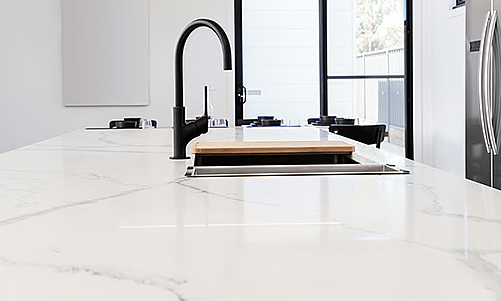Filling defects in a granite surface demands meticulous care and the proper materials to guarantee a smooth, imperceptible finish coordinating with the surrounding stone. Known for its longevity and visual appeal, granite sometimes endures unintended impacts or structural imperfections leading to voids or significant chips. Here are effective strategies to address such blemishes.
Initially assess the measurement and profundity of the imperfection. This evaluation will help choose the suitable volume of epoxy or resin essential to adequately load the space. Smaller flaws (a couple millimeters in diameter) can usually be handled with a straightforward epoxy kit, while more substantial gaps may necessitate a more robust filling compound and potentially a more involved color matching process.
Thoroughly clean the location, removing any debris and dust from the void and encompassing region with a vacuum cleaner, then clean with a delicate granite cleanser and a soft material to guarantee the epoxy adheres appropriately.
Select a high-quality epoxy resin intentionally designed for stone repair. For superior aesthetics, pick an epoxy that can be tinted to coordinate with your granite’s color and vein-like patterns. These kits regularly include a selection of pigments that can be combined to accomplish a close resemblance.
Abide by the manufacturer's instructions to blend the epoxy resin with the hardener and tint employing the colorants supplied. Achieving the proper color mix may require several tries; test the color on a similar substance or in an inconspicuous area initially to confirm it matches well.

Carefully load the void with the blended epoxy utilizing a putty blade or a comparable applicator. Overfill it somewhat to account for the gentle shrinkage that arises as the epoxy cures. Smooth the surface as much as feasible with the knife to reduce sanding later.
Allow the epoxy to cure as indicated by the epoxy manufacturer’s timeframe—typically 24 hours. Once cured, sand the region with fine-grit sandpaper, starting with 220-grit and working up to 600-grit or higher to accomplish a smooth, polished surface.
Finally, polish the repaired area with a granite polishing compound to restore luster and blend the repair into the surrounding countertop. After polishing, apply a granite sealer over the entire countertop to protect the repair and the stone’s surface.
Maintain the integrity of the repair and the rest of the countertop by cleaning regularly with a granite-approved cleaner and resealing the surface annually, or as recommended by the sealer manufacturer.
By following these steps, you can effectively fill defects in your granite countertop, restoring its beautiful, seamless appearance. For detailed guidance and materials, consider visiting tapar agujero encimera granito for more comprehensive repair solutions.With the right approach, your countertop can continue to be a valuable and attractive part of your kitchen.